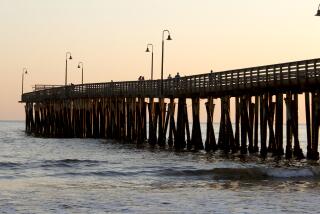Plans for Anchor Trailer Port will unmoor dozens in Costa Mesa
- Share via
Plans are in the works at the 1940s-era Anchor Trailer Port in Costa Mesa to convert the residential park to condominiums. But as decisions and approvals make their way through administrative channels, some residents say they feel confused, cheated and adrift.
Others know the change was inevitable but just want their fair share of moving costs and per diems. The tentative move-out date is Aug. 24.
The developers say they hear residents’ concerns and are being generous. City staff has chipped in more than 100 hours toward the task of helping them move.
But that has done little to allay the apprehensions and uncertainty of some residents. Anchor Trailer Port has been their home for years, and they don’t know where their next home will be once it closes.
The park is at 1527 Newport Blvd., but to find the nearly 1.9-acre space near the Newport Beach border, a visitor would have to look hard. Its tucked-away nature belies its position on a major thoroughfare. It’s a home hidden in plain sight, just as the residents like it.
They think of their 43-space slice of Costa Mesa a secret, affordable jewel. They know their neighbors, their neighbors know them, and sometimes they don’t even feel the need to lock their doors.
Anchor Trailer Port’s history dates to the 1940s, when it opened as a park for recreational vehicles, according to a city report. Through the decades, it became a state-licensed mobile home park where people of all ages can live.
As of earlier this month, 20 spaces had resident-owned homes, nine had park-owned homes and one was occupied by the on-site manager, the city said. Thirteen spaces are vacant.
IntraCorp, a privately held company, is the proposed buyer of the property. With recent approvals from the City Council and Planning Commission, 40 live-work condominiums are to replace the mobile homes, RVs and trailers. Prices have not yet been released.
Mike Libby is one of the Anchor residents who are uncertain about their future. For 16 years, he has lived in a single-wide mobile home there. He owns his house and leases the plot, which is close to his job at the marina.
He likes having his own small carport and yard. Neighbors say he has the best lemon tree around. But he knows his 1960s-era home is too old and decrepit to be moved when the time comes to leave. City staff has acknowledged that spaces for mobile homes and similar dwellings are in short supply in Costa Mesa and environs.
“Dude, I’ve been to a bunch of parks,” Libby said. “There’s just nothin’ out there, ya know? I looked at a house for rent over here, called it. It was a little small, one-bedroom thing. Perfect. But they said it was rented out.”
Another resident, Jeanne McMahon, has Alzheimer’s disease but said she feels fortunate because Hoag Memorial Hospital Presbyterian is just down the road; her doctors are close by. She doesn’t drive anymore.
Asked about her future home, she teared up. “I don’t know. I have no idea.... I feel uneasy, scared, although I have many, many friends,” she said. “God has taken care of me.”
After 21/2 hours of public testimony and discussion, the City Council on Jan. 8 certified that Anchor Trailer Port’s closure impact report met state requirements. The report outlined effects of the closure, residents’ relocation options and mitigations.
Peter Lauener of IntraCorp’s Newport office was there listening and speaking to the council.
“We understand that closing a trailer park is a very sensitive process,” he said in an interview. “So we’ve tried to be very sensitive to the residents who live there. The reality is that it’s owned by a landowner whose goal is to convert it from what it is to something else, and he’s retained us to do that.”
According to the latest closure impact report available, IntraCorp’s relocation options for renters and homeowners include moving, salvaging or buying the structures. Licensed businesses will do the moving.
Residents who meet certain requirements will also get $5,500, the others $2,000.
Peter Naghavi, Costa Mesa’s deputy chief executive and economic and development services director, echoed Lauener’s sentiment that the conversion process is always difficult.
“We are not going to do anything to hurt our residents,” Naghavi added. “Our job is to make sure that we protect our residents by making sure that [the developers] do what they’re supposed to do.”
More to Read
Sign up for Essential California
The most important California stories and recommendations in your inbox every morning.
You may occasionally receive promotional content from the Los Angeles Times.











